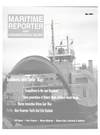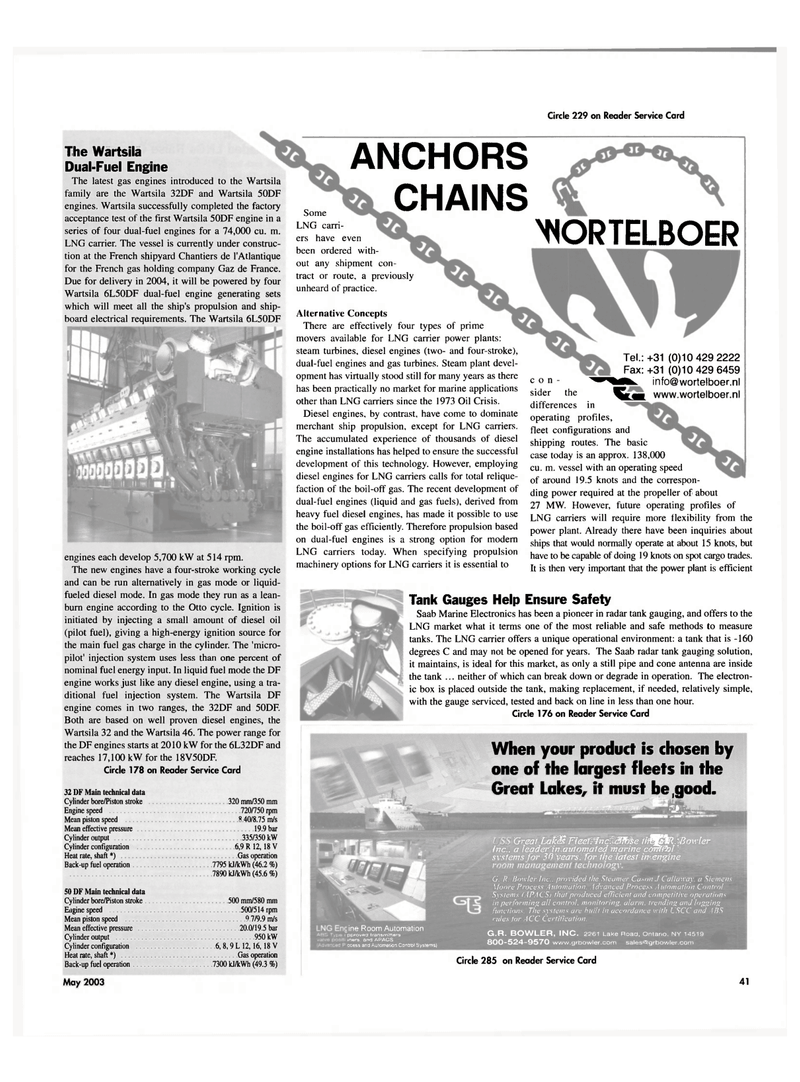
Page 41: of Maritime Reporter Magazine (May 2003)
Read this page in Pdf, Flash or Html5 edition of May 2003 Maritime Reporter Magazine
Circle 229 on Reader Service Card
The Wartsila
Dual-Fuel Engine
The latest gas engines introduced to the Wartsila family are the Wartsila 32DF and Wartsila 50DF engines. Wartsila successfully completed the factory acceptance test of the first Wartsila 50DF engine in a series of four dual-fuel engines for a 74,000 cu. m.
LNG carrier. The vessel is currently under construc- tion at the French shipyard Chantiers de l'Atlantique for the French gas holding company Gaz de France.
Due for delivery in 2004, it will be powered by four
Wartsila 6L50DF dual-fuel engine generating sets which will meet all the ship's propulsion and ship- board electrical requirements. The Wartsila 6L50DF engines each develop 5,700 kW at 514 rpm.
The new engines have a four-stroke working cycle and can be run alternatively in gas mode or liquid- fueled diesel mode. In gas mode they run as a lean- burn engine according to the Otto cycle. Ignition is initiated by injecting a small amount of diesel oil (pilot fuel), giving a high-energy ignition source for the main fuel gas charge in the cylinder. The 'micro- pilot' injection system uses less than one percent of nominal fuel energy input. In liquid fuel mode the DF engine works just like any diesel engine, using a tra- ditional fuel injection system. The Wartsila DF engine comes in two ranges, the 32DF and 50DF.
Both are based on well proven diesel engines, the
Wartsila 32 and the Wartsila 46. The power range for the DF engines starts at 2010 kW for the 6L32DF and reaches 17,100 kW for the 18V50DF.
Circle 178 on Reader Service Card
Some
ANCHORS
CHAINS
LNG carri- ers have even been ordered with-
YIORTELBOER out any shipment con-
Tel.: +31 (0)10 429 2222
Fax: +31 (0)10 429 6459 c 0 n - inf°@w°rte,koer.nl sider the ^LM. www.wortelboer.nl differences in operating profiles, fleet configurations and shipping routes. The basic case today is an approx. 138,000 cu. m. vessel with an operating speed of around 19.5 knots and the correspon- ding power required at the propeller of about 27 MW. However, future operating profiles of
LNG carriers will require more flexibility from the power plant. Already there have been inquiries about ships that would normally operate at about 15 knots, but have to be capable of doing 19 knots on spot cargo trades.
It is then very important that the power plant is efficient tract or route, a previously unheard of practice.
Alternative Concepts
There are effectively four types of prime movers available for LNG carrier power plants: steam turbines, diesel engines (two- and four-stroke), dual-fuel engines and gas turbines. Steam plant devel- opment has virtually stood still for many years as there has been practically no market for marine applications other than LNG carriers since the 1973 Oil Crisis.
Diesel engines, by contrast, have come to dominate merchant ship propulsion, except for LNG carriers.
The accumulated experience of thousands of diesel engine installations has helped to ensure the successful development of this technology. However, employing diesel engines for LNG carriers calls for total relique- faction of the boil-off gas. The recent development of dual-fuel engines (liquid and gas fuels), derived from heavy fuel diesel engines, has made it possible to use the boil-off gas efficiently. Therefore propulsion based on dual-fuel engines is a strong option for modern
LNG carriers today. When specifying propulsion machinery options for LNG carriers it is essential to
Tank Gauges Help Ensure Safety
Saab Marine Electronics has been a pioneer in radar tank gauging, and offers to the
LNG market what it terms one of the most reliable and safe methods to measure tanks. The LNG carrier offers a unique operational environment: a tank that is -160 degrees C and may not be opened for years. The Saab radar tank gauging solution, it maintains, is ideal for this market, as only a still pipe and cone antenna are inside the tank ... neither of which can break down or degrade in operation. The electron- ic box is placed outside the tank, making replacement, if needed, relatively simple, with the gauge serviced, tested and back on line in less than one hour.
Circle 176 on Reader Service Card 32 DF Main technical data
Cylinder bore/Piston stroke 320 mm/350 mm
Engine speed 720/750 rpm
Mean piston speed 8.40/8.75 m/s
Mean effective pressure 19.9 bar
Cylinder output 335/350 kW
Cylinder configuration 6,9 R 12,18 V
Heat rate, shaft *) Gas operation
Back-up fuel operation 7795 kJ/kWh (46.2 %) 7890 kJ/kWh (45.6 %) 50 DF Main technical data
Cylinder bore/Piston stroke 500 mm/580 mm
Engine speed 500/514 ipm
Mean piston speed 9.7/9.9 m/s
Mean effective pressure 20.0/19.5 bar
Cylinder output 950 kW
Cylinder configuration 6, 8,9 L 12,16,18 V
Heat rate, shaft *) Gas operation
Back-up fuel operation 7300 kJ/kWh (49.3 %)
May, 2003
When your product is chosen by one of the largest fleets in the
Great Lakes, it must be good. 'is-
Great LalMFleet: Incf&M'etlt^ffR.A Inc.. a leader in automated marine conical systems for 30 years, for the latest in engine room management technology. fm--Bo\rler ml: ine Room Automation pproved transmitters iners. and APACS ccess and Auiorrsation Control Systems)
G. R. Bowler Inc.. provided the Steamer Ca.-on./ Callaway a Siemens
Moore Process Automation. Advanced Process A utomation Control
Systems ('APACS,) that produced efficient and competitive operation v in performing all control, monitoring, alarm, trending and logging functions The systems arc built in accordance with L SCC and ABS rides for ACC Certification.
G.R. BOWLER, INC. 2261 Lake Road, Ontario. NY 14519 800-524-9570 www.grbowler.com sales'S.'grbowler.com
Circle 285 on Reader Service Card 41

 40
40

 42
42
